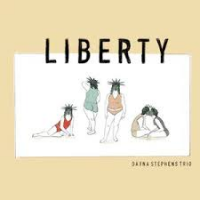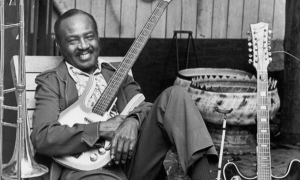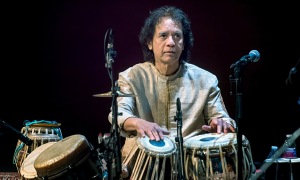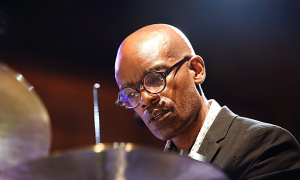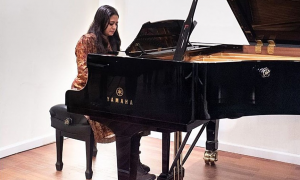Home » Jazz Articles » Under the Radar » The Archive of Contemporary Music
The Archive of Contemporary Music

Music can’t be judged in its own time.
—B. George
Full-time staff includes director/co-founder Bob George, Fred Patterson—the resident jazz expert—and a position yet to be filled following the departure of another employee. Three to four volunteers are on hand at any given time and Mr. George typically recruits college students in Library Science programs, giving them hands-on experience in cataloging. And there is a lot to catalog. In 2012 ARC became a boot camp for Pratt University Library Science students who digitized one-thousand music books not available online. ARC, besides recordings, houses music books, memorabilia of all kinds, old concert programs, some equipment such as turntables, and other miscellaneous items. Some walls of the archive are obscured behind boxes of assorted items in the process of being organized. In a large room to the side, a volunteer staffer sorts through some of the seven-hundred-fifty-thousand 45 rpm records. For all the moving parts, the daily operations of ARC are busy but orderly. In these surroundings where music stretches as far as one can see, no music plays. It is as quiet as a library.
Bob George (who goes by the initial "B") is a native of Youngstown, Ohio. He attended the University of Michigan College of Art and Design before moving to New York in 1974, studying at the Whitney Museum. George co-directed Laurie Anderson's stage shows from the mid-to-late 1970s and formed One Ten Records in 1977. His label produced the first commercial collection of audio works by visual artists, including Anderson, previously unreleased work by Meredith Monk, and George's own music. In 1980 George was awarded a National Endowment for the Arts grant to continue his project to produce recordings by visual artists and the following year he produced Anderson's first single "O Superman." The Anderson track reached number two on the UK charts and placed in the top twenty in sixteen countries. In 1980 his company published Volume: The International Discography of the New Wave. George was an occasional contributor to the BBC radio program The John Peel Show (1967-2004). The broadcast was a platform for the music of the UK underground. George began working as a DJ at NYC clubs shortly after arriving in the city and he accumulated albums from record companies, clubs that had closed, and from his work as a producer. Eventually, his collection exceeded forty-thousand, and growing exponentially; a more suitable storage solution was an inevitable necessity.
Building The ARC
In 1985 George and Boston-based collector David Wheeler (1957—1997), whose own collection at the time was approximately one-hundred-thousand albums, launched ARC. The initial ARC location was George's own Tribeca loft. In 1989 they moved to a third-floor Soho location and in 1996, to their current location at 54 White Street. Some collections, such as World Music, are currently housed in other locations. Once established, donations—not always in the form of recordings—flowed in. Hard Rock Café founder, Isaac Tigrett, donated computers, and audio equipment in 1986 and an unnamed software developer contributed a gift of fifty-thousand dollars the following year. ARC's collections include press kits, posters, collectibles, songbooks, picture discs, photographs, audio equipment, sheet music and more. But, by and large, recorded music accounts for the donations not just from institutions, defunct clubs, and record labels, but many from individual collectors including Mick Jagger and David Byrne. The founder of A-Square Records, Hugh "Jeep" Holland, whose home was sinking from the weight of his LP collection, donated more than one-hundred-thousand important recordings in the rock, jazz, blues, and pop genres. Included in the Holland collection was the The Rolling Stones first album in pristine condition and autographed by all the band members. In 2012, Edward J. Ward, the founder of the Milwaukee Irish Fest, loaded a U-Haul with forty-six-thousand 45 rpm records and hundreds of music magazines and drove them to the ARC facility. Of the many collections donated to ARC, the one that B. George seems most proud of is the Keith Richards' Blues Collection. Richards, a member of the ARC Board of Advisors since 1991, is a connoisseur of the Blues genre whose collection of more than ten-thousand recordings includes the rare Robert Johnson 78, "Me and The Devil Blues"/"Little Queen of Spades" (Vocalion, 1937).Mr. George takes on a significant role in bringing recorded material to the archive. He has traveled to Brazil, Cuba, Europe, and Africa, multiple times, for conferences, to give speeches, and most importantly, to acquire new and unique collections. On a 2009 trip to Amman, Jordan, ARC put in motion an initiative in partnership with Columbia University's Middle Eastern Research Center: Muslim World Music Day. ARC now hosts an archive of Middle Eastern music. Beginning in 2011 ARC began hosting these "music days" to explore the sounds of unique cultures. Along with Muslim World Music Day, the organization has featured Brazilian, Indian, and Cuban events working with partnering sponsors such as the Libraries at Columbia University, the Internet Archive, and Atlantic Records and Gracenote.
ARC's Board of Advisors have informal roles within the organization but past and present advisors include top names in many entertainment and media fields. Current board members comprise of Jellybean Benitez, Youssou N'Dour, Keith Richards, Nile Rodgers & CHIC, Todd Rundgren, Fred Schneider (B52s), Martin Scorsese, Paul Simon, and others. ARC's Emeritus Board included David Bowie (1947—2016), Carl Bernstein, Jonathan Demme (1944-2017), John Hammond Jr. (1910—1987), Jerry Leiber (1933—2011), and Lou Reed (1942—2013).
ARC provides several client services from scanning album artwork to renting physical space for special events. Among their most important utilities is the ARC Research function. In 1996 the organization initiated Research Memberships beginning with Tommy Boy Records as the label sought information on rights for sampling. Whether members are looking for a master tape or tracking down an obscure recording credit, ARC provides made-to-order research; they have consulted for Microsoft Music Central, the Grammy Hall of Fame, and the Jazz Hall of Fame among many others. ARC provides substantial research and recordings for the film and television industries. Among their projects have been Ken Burns' PBS documentary, Baseball, the documentary film Muscle Shoals, two Jonathan Demme films, Philadelphia and The Manchurian Candidate, and Martin Scorsese's The Last Temptation of Christ. In 2007 ARC conducted research and provided artwork and album covers for a Rock'n'Roll exhibition at The Fondation Cartier pour l'Art Contemporain in Paris.
Weird Scenes Inside the Gold Mine
One day in January of 2020 I visited with B. George at ARC. Through an article in the New York Times, I learned that the landlord of 54 White Street was about to impose a prohibitive rent increase and the non-profit needed to find a new home. Not knowing this massive repository of recordings existed, a day trip was in order. No one with a strong affinity for music could walk through this door and not feel like they had stumbled onto the Holy Grail. Posters, programs, paraphernalia, and LPs as far as the eye can see. But it is only upon digging into the shelves that the real peculiarities of the recording world are revealed.Mr. George takes me through the labyrinth of aisles pointing out some of the more unusual LPs in the archives; interviews with John F. Kennedy assassin Lee Harvey Oswald, Third Reich marches, songs, and spoken word propaganda, a Louis Armstrong single recorded as a promotion for a floor tile company, and packaged with a tile sample, and disgraced televangelist Jimmy Swaggart's "Greatest Hits." Two of the most unusual recordings came out of the second "Golden Age of Calypso" in the 1950s. One, Miss Calypso (Scamp Records, 1957) is the only musical recording from writer and poet Maya Angelou. In one of her seven autobiographies, Angelou re-counts Billie Holiday walking out of her live performance of the material. More surprising is a 10" single "Back to Back, Belly to Belly" (Monogram Records, 1954) written and performed by The Charmer. "The Charmer" is Louis Farrakhan, the controversial minister and political activist.
Among the genre collections housed with ARC are Asian Indian albums, Bellydance, and Country & Western. George is proud of a wall displaying the first dozen LPs issued by the fabled Sun label. These albums include Roy Orbison, Jerry Lee Lewis, Carl Perkins, and several from Johnny Cash. A selection of Bluegrass recordings covers luminaries such as Bill Monroe and Doc Watson, along with long-forgotten groups like the Knob Lick Upper 10,000 and The Coon Creek Girls. There is an "Activist" catalog that features Reaganomics protest music and a selection of "no-nukes" recordings. More unusual albums in that vein are United Auto Workers supporter, Joe Lisi, bolstering that union with It's The UAW All The Way (Lem, 1965), and jazz singer Barbara Dane's I Hate The Capitalist System (Paredon, 1973). Equally fascinating—if not quite as historically significant—is the "Almost The Beatles" collection. No longer surprising are albums that treat Beatles music to baroque stylings, a symphony orchestra, or a synthesizer, but things are a lot quirkier at ARC. There is the self-titled The Beatle Buddies (Diplomat, 1964), an all-female quartet who had previously issued the same recording as The Manchesters; Os Sambeatles is a collection of Bossa Nova takes on early Beatle hits from a Brazilian band called Manfredo Fest Trio; and The Blue Beats' The Beatle Beat (A.A. Records, 1964) which includes no Beatle songs, but, apparently, their "beat." The Tchaikovsky inspired Beatle Cracker Suite from Arthur Wilkinson's Orchestra (His Master's Voice, 1965). The ballet re-working of John Lennon/Paul McCartney classics was Wilkinson's only recording. ARC has a sizable display of "Space" oriented albums including spoken word releases such as Leonard Nimoy's The Green Hills Of Earth (Caedmon Records, 1977) and Walter Cronkite's Man On The Moon (CBS, 1969). Science Fiction musical entries include Sid Bass' From Another World (VIik, 1956) and a group called Space with Tango In Space (Vogue, 1977) which is not tango music, but experimental disco. And, while there are many Sun Ra recordings at ARC, they are respectfully housed in the jazz archives. As George shows me some of the many curious albums, we talk about the musical choices that some artists have made; one-hit-wonders, career-altering (or killing) releases, dubious hybrid musical inventions. But viewing these outliers in retrospect, George suggests that "Music can't be judged in its own time."
A Different Kind of Jazz Loft
On the shelves that hold part of the enormous jazz inventory, the familiar orange and black spines of Impulse! recordings immediately catch the eye. ARC has over four-hundred of the label's releases including duplicates. By no means the largest label collection, the archive holds more than fifteen hundred Blue Note recordings and over twenty-five hundred from Verve. The collections include more than three-hundred John Coltrane LPs, five-hundred-plus from Miles Davis, and nearly seven-hundred Duke Ellington discs. ARC holds many rare discs from Europe including a Denmark release from Billie Holiday and Ellington from Italy. Less rare, but still hard to find are George Adams/Don Pullen Quartet (Netherlands), Lester Young (France), and a live 1962 performance from Coltrane and Eric Dolphy (France). In 2013 ARC began working with the estate of saxophonist Steve Lacy to create a digital archive of his handwritten manuscripts and notebooks, including over five hundred compositions, some never published. The Archive is not limited to jazz recordings having categorized over one-thousand books with some link to the genre.Almost all of the labels that recorded black jazz artists in the 1920s—the so-called race labels—went out of business with the onset of the Great Depression. Relatively rare, ARC holds an impressive and historically important collection such as Okeh Records (in its original business model) with more than sixty 78 RPM from Count Basie, Cootie Williams, Mamie Smith, and the Mississippi Sheiks. The collection includes dozens of releases from the early Paramount label (1917-1932), including sides from Duke Ellington, Fats Waller, the Norfolk Jazz Quartet, and blues legends Ma Rainey and Blind Lemon Jefferson. ARC's collection also includes thirty-eight Vocalion 78s and several rare recordings from the only African American owned race label, Black Swan. Like many major labels, companies such as Columbia issued separate "Race Series" divisions marketed to black music consumers and designated by specific numerical coding. Under that label, ARC has releases from Bix Beiderbecke, Louis Armstrong, Basie, the Original Jazz Hounds, and Bessie Smith. The archive's Bluebird collection includes Jelly Roll Morten, Hot Lips Page, Sonny Boy Williamson II.
The Great 78 Project
B. George wears another hat -serving as curator of the Internet Archive's (IA) ongoing initiative to preserve and digitize 78 rpm recordings. IA began the project in 2016 and utilizes George Blood Audio in the Chestnut Hill neighborhood of Philadelphia. The fragile and aging collections of shellac discs have come in from all over the globe; some collections in the hundreds, others, tens of thousands. Donations have come from institutions such as the Batavia Illinois and Boston Public Libraries, Kansas State University, and the University of San Francisco's public radio station, KUSF. ARC contributes thousands of its own 78s to the project. Many more donations to IA come from private collections such as the Daniel McNeil collection of over twenty-thousand ten and twelve-inch 78s and journalist David Hinckley's collection of country, cowboy, western swing and hillbilly 78s. The Larry Edelman collection is largely square dance music and calls and the Nelson Collection is comprised of cowboy songs, hobo songs, early Hawaiian music, Vaudeville records, and Foxtrot recordings.Many collections include recordings from outside the U.S. The Chomowicz/Ready collection includes 78s from Latin America and Cuba. The Walikis Polka collection includes Eastern European and Balkan folk and traditional music, and the Tina Argumedo and Lucrecia Hug collection of 78s includes tango, boleros, sambas, and mambo recordings from 1930s Argentina. The prime years of 78 rpm records—1910-1950—blanketed the most popular era of jazz, so the genre has a significant presence among donations. The Bradburn Collection contains almost one-thousand 78s including multiple discs from Billie Holiday and Illinois Jacquet and numerous Latin Jazz recordings. Machito and his Afro-Cubans (1940) included the pioneering Mario Bauza, who introduced Cuban music of the era to the NYC jazz scene. Trio Los Panchos formed in 1944 by Chucho Navarro, Alfredo Gil, and Hernando Avilés and became leading proponents of the bolero in Latin America. The Seldon Family collection begins with Walter Seldon who grew up in Jazz Age New York City and developed an appetite for Dixieland and Big Band music. While still in his teens he attended a Duke Ellington recording session and hosted a jazz radio program on WALD while on breaks from Cornell University. Years later he and his wife Dolores opened their home to visits from Dizzy Gillespie, James Moody, Roland Hanna, and Mike Longo and other top jazz artists. Richard Thayer Skidmore's father was a bassist who played with the bands of Charlie Barnet, The Dorsey Brothers, Glen Miller, Eddie Condon, and Jack Teagarden among others. The Skidmore collection includes approximately fourteen-hundred jazz 78s and about two-hundred and fifty Edison discs. The Edison discs were a relatively brief experiment form Thomas Edison; these heavy discs were almost one and a half pounds and nearly a quarter of an inch thick. Not compatible with standard phonographs, the Edison discs were cut laterally with up-and-down variations in the size of the grooves. Reportedly, the sound quality was superior to 78s. The Edison discs were played using needles sold in packages of ten and each needle worked efficiently for only one play. Though they were manufactured from 1912 to 1929, their peak popularity ran only from 1915 to 1920. Edison had released two recordings of the Frisco "Jazz" Band in 1919 but his eclectic catalog was dominated by opera and classical concert music, military marches, spoken word collections, and sentimental ballads. The Skidmore collection is housed at ARC along with memorabilia donated with the discs.
The Future of ARC
You won't find a barista or a souvenir key chain at the The Archive of Contemporary Music and those commercial aspects remain off the drawing board. B. George keeps the operation trade-free though ARC hosts two sales of selected material each year to raise money and clear out overstock. During the first weekend of March 2020 (before the extent of the coronavirus pandemic became widely known), ARC called for volunteers to begin the process of sorting and packing up "LPs, CDs, videos, magazines, flexi-discs, press kits, posters, knick-knacks, songbooks, swag, picture discs, photographs, singles, 78s, EPs, 8-tracks, audio equipment, cassettes, acetates, metal parts, reel-to-reels, books, paper records, mini-discs, computers, DATs, sheet music..." and more, in preparation of moving from 54 White St. to an as yet undisclosed location. In ARC's next incarnation George envisions a larger, more interactive space suitable for hosting performances and facilitating seminars and workshops. But beyond designing the concept and infrastructure, he will leave the day-to-day in the hands of whoever eventually succeeds him at ARC. The ARC website is almost as entertaining as the physical site. Visit it at: https://arcmusic.org/about/.Sampling ARC's Discology
Anything remotely resembling a snapshot of the Archive's LP catalog would fill a book. ARC's website provides a searchable database that can be manipulated across several fields. It's worth a look. Below are three albums that provide a very miniature sketch of ARC's collections—three albums that represent both the jazz world and the broader world of music. The Jazz Messengers: The Jazz Messengers
The Jazz Messengers: The Jazz Messengers(Columbia, 1956)
Before Art Blakey's name stood apart, there was The Jazz Messengers. Columbia Records released their self-titled studio debut in 1956 featured an all-star quintet with Hank Mobley on tenor, trumpeter Donald Byrd, pianist Horace Silver, bassist Doug Watkins, and drummer Blakey. Silver and Mobley wrote five of the seven hard bop compositions. The ARC connection to the album is Muslim World Music Day. Blakey was also Abdulla Ibn Buhaina, a mid-1950s convert to Islam in the. In addition, the drummer's previous, but short-lived, ensemble, the Seventeen Messengers, was predominantly made up of Muslim musicians including Sahib Shihab, tenor saxophonist Orlando Wright (Musa Kaleem), Kenny Dorham (Abdul Hamid), trombonist Howard Bowe (Haleen Rasheed), and pianist Walter Bishop, Jr. (Ibrahim Ibn Ismail).
 Mario Bauzá And Friends—Afro-Cuban Jazz
Mario Bauzá And Friends—Afro-Cuban Jazz (Caiman Records, 1986)
Mario Bauza was a Cuban trumpeter, reed player, arranger, composer and one of the first to bring the island's music to the New York jazz scene with an urbane blend of styles that went beyond popular Cuban jazz tunes. His "Tangá" was the first piece to intermingling jazz with clave rhythm, establishing Afro-Cuban jazz as a sub-genre. He began honing the hybrid style in the 1940s while he was the music director of Machito and his Afro-Cubans, influential in the innovative synthesis of Cuban clave and the melodies and harmonies of jazz.
 Count Basie and His Orchestra: Basie's Beatle Bag
Count Basie and His Orchestra: Basie's Beatle Bag(Verve, 1966)
With an eighteen-piece band and arrangements by Chico O'Farrill, Basie takes on material from the earlier Beatles albums. With the exception of Leiber & Stoller's "Kansas City" (covered several times by the Beatles), Basie undertakes classics such as "Help!," "Can't Buy Me Love," and "Hard Day's Night." The more up-tempo Lennon/McCartney pieces lend themselves well to O'Farrill and Basie's swing interpretations.
Tags
PREVIOUS / NEXT
Support All About Jazz
 All About Jazz has been a pillar of jazz since 1995, championing it as an art form and, more importantly, supporting the musicians who make it. Our enduring commitment has made "AAJ" one of the most culturally important websites of its kind, read by hundreds of thousands of fans, musicians and industry figures every month.
All About Jazz has been a pillar of jazz since 1995, championing it as an art form and, more importantly, supporting the musicians who make it. Our enduring commitment has made "AAJ" one of the most culturally important websites of its kind, read by hundreds of thousands of fans, musicians and industry figures every month.



